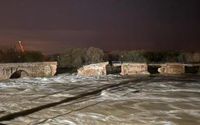Spain is weathering unprecedented rains as storm Martinho wreaks havoc for the third consecutive week, resulting in widespread flooding and evacuations.
On March 23, 2025, the country faced severe precipitation which led to hundreds of evacuations and devastating consequences including the loss of three lives. The storm has prompted the issuance of orange and yellow weather warnings across various regions due to concerns of rain, snow, wind, and high waves along the coast.
In Talavera de la Reina, a historic Roman bridge, known as the Puente Viejo or Puente de Santa Catalina, suffered significant destruction as the swollen Tagus River swept away sections of the structure. Two segments of the bridge collapsed amid the rising waters, marking a significant loss for the municipality considering the bridge's historical and cultural importance. The bridge, originally built during Roman times and rebuilt in the 15th century, was closed months ago due to safety concerns.
The local police swiftly cordoned off the area to keep pedestrians and vehicles clear as emergency services assessed the ongoing risks. Mayor of Talavera de la Reina expressed profound sadness over the bridge’s loss, emphasizing that the bridge's prior closure likely prevented further casualties.
As storm Martinho continued its path north towards Catalonia, rainfall intensified further in Barcelona and its surrounding areas. The Catalan Meteorological Service, Meteocat, issued yellow weather alerts for the provinces of Barcelona, Girona, and Tarragona citing severe rainfall and gusty winds. Between 6:00 AM and 12:00 PM on the same day, torrential downpours inundated streets in Barcelona, prompting warnings from the authorities to exercise caution and limit travel.
Wind gusts reaching up to 100 kilometers per hour were recorded in regions previously struck by the storm, including Galicia and Asturias. The rain forecasted for later in the day could further increase flooding risks in low-lying regions with standing water accumulating on streets and highways.
The public transport system also faced disruptions, with metro and train services experiencing delays or temporary suspensions due to flooding on the tracks, urging travelers to check for real-time updates before traveling.
On the day of the storm, temperatures across Barcelona remained mild, peaking at around 17 degrees Celsius, while winds continued to blow strong with gusts of up to 60 kilometers per hour, particularly affecting coastal and mountainous regions.
As authorities in Talavera de la Reina inspected the situation, they warned residents in multiple regions—including parts of Castilla-La Mancha, Madrid, and Ávila—about overflowing rivers and the potential for more evacuations due to the continuing risks posed by rising waters. Experts pointed out the increased frequency of extreme weather due to climate change, which has made storms like Martinho more common.
Local residents expressed their dismay at the destruction wrought by the storm, particularly mourning the loss of the historic Puente Viejo bridge, a cherished landmark in Talavera de la Reina. The government and emergency services have mobilized to prevent further damage and ensure the safety of residents.
Looking ahead, Rubén del Campo, spokesman for the State Meteorological Agency (Aemet), provided a glimmer of hope: while rain was expected to persist through Monday, March 24, conditions are projected to stabilize somewhat after 21 consecutive days of rainfall. Meteorologists anticipate a decrease in precipitation moving into the following week, although the ground's saturation may lead to flooding risks as melted snow contributes to already elevated water levels.
With both authorities and residents bracing for ongoing weather challenges, the consequences of storm Martinho highlight the critical nature of preparation and response to increasingly severe climate events in Spain.






